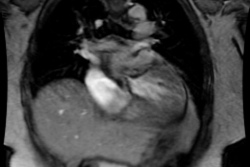Corrected Transposition of the Great Arteries (Levo-transposition of the great arteries or L-TGA)
Clinical:
Corrected transposition is rare- accounting for only 0.4-0.6% of all cases of congenital heart disease [1]. There is a male predilection [6]. In corrected transposition there is:Atrial situs solitus- the morphologic right atrium is on the right side of the heart and receives blood from the superior and inferior vena cava. The morphologic left atrium is on the left side of the heart and the pulmonary veins drain to this chamber.Therefore the systemic blood returning to the heart is directed to the lungs, but via the LV; and blood bound for the systemic circulation enters the aorta- but via the RV [3]. The aorta is anterior, superior, and to the left of the main pulmonary artery. The atrioventricular valves remain with their respective ventricles. The coronary arteries are inverted- the right coronary artery is on the left, and the left coronary artery is on the right. The right ventricle becomes hypertrophied as it exposed to systemic pressures and eventually develops failure or tricuspid regurge in most patients [5]. Because physiologic circulation occurs, patients can be asymptomatic during childhood and not present until later in life [6].
Atrioventricular discordance- the right atrium connects to the morphologic left ventricle, while the left atrium connects to the morphologic right ventricle [3].
Ventriculoarterial discordance- ie: the aorta originates from the right ventricle and supplies the systemic circulation, and the pulmonary artery from the left ventricle and supplies the pulmonary circulation [3].
Associated cardiac anomalies are found in 90-99% of cases such as
VSD (72-80% and most commonly perimembranous), pulmonary stenosis
(40-50% and primarily subvalvular, but can also be valvular),
LVOTO (30%), or Ebsteins anomaly (30%) [1,6]. Tricuspid valve
abnormalities are common (90% of cases) with the most important
being dysplasia [6]. Dextrocardia is found in about 25% of cases
[1]. The patients are not cyanotic [4], but develop right heart
failure (as the RV attempts to supply the systemic circulation)
and heart block develops in about 30% of patients [1].
To achieve anatomic correction, the patient (typically between
the ages of 7 months and 3 years)undergoes an atrial correction
procedure (either the Senning or Mustard procedure) and a Jatene
arterial switch, or an atrial switch and a Rastelli-type repair
[3]. The double switch procedure (senning-Rastelli) consists of a
concomitant atrial baffle and arterial switch [5]. It is commonly
performed in two stages when no pulmonary stenosis or VSD results
in LV systolic pressure [5]. Anatomic repair requires equal sized
ventricles [6]. The first stage consists of banding the PA to
increase subpulmonary LV afterload and wall thickness [5]. The
second stage consists of PA band removal, arterial switch, and
atrial switch [5].
X-ray:
MRI: The aorta and PA are oriented parallel to each other in the sagittal or coronal plane [6]. The aorta is connected to the thick-walled morphologic RV, positioned to the left, which gives the impression of a normal connection [6]. The normal right ventricle has a muscular infundibulum separating the atrioventricular and semilunar valves, trabeculations, and a moderator band. The morphologic left ventricle has no muscular infundibulum, is smooth walled, and there is fibrous continuity of the atrioventriular and semilunar valves [1]. The LA connects to the RV via a tricuspid valve [6].REFERENCES:
(1) Radiology 1999; Reddy GP, Caputo GR. Case 15: Congenitally
corrected transposition of the great arteries. 213: 102-106
(2) Radiographics 2007; Leschka S, et al. Pre- and postoperative evaluation of congenital heart disease in children and adults with 64-section CT. 27: 829-846
(3) Radiology 2008; Gaca AM, et al. Repair of congenital heart disease: a primer-part 1. 247: 617-631
(4) Radiographics 2010; Frank L, et al. Cardiovascular MR imaging
of conotruncal anomalies. 30: 1069-1094
(5) J Cardiovasc Comput Tomogr 2013; Han BK, Lesser J. CT imaging
in congenital heart disease: an approach to imaging and
interpreting complex lesions after surgical intervention for
tetrology of Fallot, transposition of the great arteries, and
single ventricle. 7: 338-353
(6) Radiographics 2021; Canan A, et al. Multimodality imaging of transposition of the great arteries. 41: 338-360





